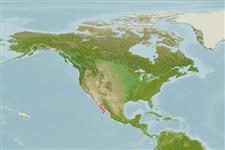>
Blenniiformes (Blennies) >
Chaenopsidae (Pike-, tube- and flagblennies)
Etymology: Acanthemblemaria: Greek, akantha = thorn + Greek, emblema, -atos, anything that is nailed, knocked in; also anything with bass or high relief (Ref. 45335); hastingsi: Named for Philip A. Hastings..
Environment: milieu / climate zone / depth range / distribution range
Ecologie
marien demersaal; diepte 1 - 3 m (Ref. 84469). Tropical
Eastern Pacific: Gulf of California (limited to Mulegé to Cabo San Lucas along the Baja Peninsula and between Isla San Pedro Nolasco and Isla San Ignacio de Farallon along the Mexican continental mainland, Ref. 26771).
Grootte / Gewicht / Leeftijd
Maturity: Lm ? range ? - ? cm
Max length : 5.1 cm SL mannelijk / geslacht onbekend; (Ref. 84469); 4.0 cm SL (female)
Korte beschrijving
Determinatiesleutels | Morfologie | Morfometrie
Dorsale stekels (totaal) : 23 - 25; Dorsale zachte stralen (totaal) : 12 - 14; Anale stekels: 2; Wervels: 42 - 44. This species is distinguished from its congeners in the Pacific, excluding its closest relatives, A. macrospilus and A. mangognatha, by having a single row of large brown blotches along its lateral midline and head spines that are pointed (vs. club-like or ridge-like). It differs from the 2 latter species by having a dark swath of melanophores on the dorsal fin in both males and females that highlights the bright orange coloration on that fin; presence of scattered melanophores reaching the tip of the lower jaw; and expression of orange as the primary bright head color. This species is further distinguishable from A. macrospilus by the 71 fixed mutations in COI and 20 fixed mutations in the D-loop region of its mitochondrial genome (Ref, 84469).
Levenscyclus en paargedrag
Maturities | Voortplanting | Spawnings | Egg(s) | Fecundities | Larven
Lin, H.-C. and G.R. Galland, 2010. Molecular analysis of Acanthemblemaria macrospilus (Teleostei: Chaenopsidae) with descriptions of a new species from the Gulf of California, Mexico. Zootaxa 2525:51-62. (Ref. 84469)
Status op de Rode Lijst van het IUCN (Ref. 130435)
Gevaar voor de mens
Harmless
Gebruik door de mens
Tools
Speciale rapporten
Download XML
Internetbronnen
Estimates based on models
Preferred temperature (Ref.
123201): 23.2 - 28.7, mean 25.6 °C (based on 138 cells).
Fylogenetische diversiteitsindex (Ref.
82804): PD
50 = 0.5000 [Uniqueness, from 0.5 = low to 2.0 = high].
Bayesian length-weight: a=0.00457 (0.00183 - 0.01143), b=3.08 (2.86 - 3.30), in cm total length, based on LWR estimates for this (Sub)family-body shape (Ref.
93245).
Trofisch niveau (Ref.
69278): 3.5 ±0.5 se; based on size and trophs of closest relatives
Fishing Vulnerability (Ref.
59153): Low vulnerability (10 of 100).
